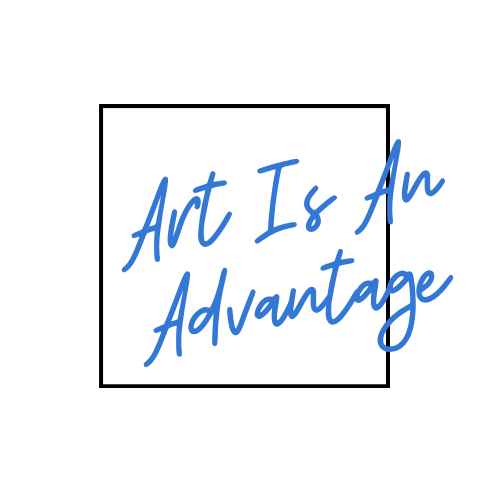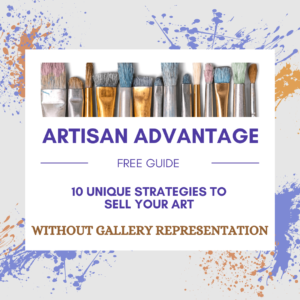by Becky Sciullo | Apr 12, 2021 | Artist Blogging 101, Artist Websites, Learning
Here are some marketing ideas for your Monday Morning
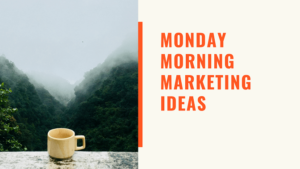 Six Art Marketing Ideas
Six Art Marketing Ideas
1 – Write a blog post about your past year. How did the pandemic affect your art and your business? Have you learned or gained anything during this time? Is it something you feel comfortable sharing? Several artists that I follow have shared this through a blog post or email newsletter, and I appreciated hearing from them on this. Do the same if you feel moved to do so for your audience.
2 – If you use WordPress, install the free plug-in Yoast SEO to help you optimize your site and posts for search with the best keywords. I use the free version and LOVE this tool.
3 – Also, on the subject of search, if you have a presence on Etsy, drive traffic to your shop by using the keywords feature in your product profiles.
4 – Mother’s Day is coming up and it’s one of the biggest gifting holidays. Can you market your art around this holiday?
5 – Consider planning your marketing content six to twelve months in advance. Think about the seasonal opportunities and events that will be coming up over the coming year and add them to your plan. This activity will make the process of creating content easier as your year progresses.
6 – Avoid “art speak” in your communications. Readers want to understand all about you and your work. The best way to do that for the largest audience is to present it in simple terms.
Get More Art Marketing Help
Would you like weekly updates with information like this to help your art business? Sign up for my mailing list here.
by Becky Sciullo | Apr 5, 2021 | Artist Blogging 101, Artist Websites, Learning, Social Media
Here are some marketing ideas for your Monday morning.
 Five Art Marketing Ideas
Five Art Marketing Ideas
1 – When strategizing about press releases – consider your college alumni magazine. Whether or not you went to the school for a fine arts degree, the information is still newsworthy, and your life experience has informed your work.
2 – Claim your social media handle before you start posting on the platform. Here is how and why to do this.
3 – If you’re getting ready to open your studio, you should read this from Artists Network.
4 – Authority is something that may cause someone to purchase your work over that of another artist. Build your authority by making sure you don’t leave out important information on your website. Authority building information includes:
- Your education.
- Any awards you’ve received.
- Classes you’ve taught.
- Exhibitions that you’ve won.ar
Don’t worry if you are starting out and don’t have much to add to the list. Blogging regularly about your practice is another way to garner authority.
5 – Yes, artists are on TikTok. If you want to jump in, go here.
Get More Art Marketing Help
Would you like weekly updates with information like this to help your art business? Sign up for my mailing list here.
by Becky Sciullo | Mar 18, 2021 | Artist Blogging 101
Once you build a blog-based website built, you need to develop a content strategy. The more frequent and relevant content you provide makes your blog a vital dynamic hub for your art business.
By putting a little thought and upfront planning into this process, you can set a system in place that provides you with a steady stream of content. This new blog post series, Artist Blogging Ideas, will feature specific ideas and examples of blog content artists can use to build their blog.
Blogging Around a Holiday
This first post is going to focus on blogging around a holiday. When planning content for your artist blog, don’t forget to plan some around the holidays. You might not hit every holiday, but consider which ones might make sense for your work. The big end-of-year holidays are obviously blog-worthy. You will want to share ideas with people interested in gifting your art, special sales, or holiday events where you are participating. But, there are more holidays to than the “big ones” to consider.
Inside Look at the St. Patrick’s Day Post

Don’t Overlook Other Holidays and Observances
In the case of Robert Yonke Art, we recently created a blog post for St. Patrick’s Day. Robert has a collection of work based on travel through Ireland, so it’s not a stretch to feature this art at this time of the year. Last year, he wrote a series called A Tour of Ireland. This most current post features work that he did not include in the series last year. It’s relevant to the holiday, and brings attention once again to this collection.
Notes on this post.
It is relevant to his art collection based upon travels to Ireland.
The featured art is not new. Some of Robert’s other collections have almost sold out, but this one still has a good amount available for sale. You can always reference work done in the past.
It’s not all about the art. If you notice in the series from last year, there were recommendations to some businesses and places in Ireland.
Notice it references and links back to the original series on Ireland from last year, in case a reader missed it.
Why this post?
Last year’s series of posts on this subject resulted in selling one original piece of art and several prints. Interestingly, the client was initially interested in a piece from the Ireland art but then purchased work from a different collection. But, a sale is a sale, and this is how it works sometimes.
Tips for writing a holiday post.
Keep it authentic. Make sure your post connects to the holiday in some way. Sure, you can put up a “Happy New Year” post, but it’s better if you can relate your work or topic directly to the holiday.
Plan ahead. I like to map content out with a content calendar a year in advance and then revisit every quarter.
Use a resource like this list of holidays and observances to help come up with ideas.
Share Your Ideas
Do you have a blog post that is written around a holiday that you could share? Or, another great idea for an artist blog topic? Drop me a line at becky@artisan-advantage.com.
Would you like a list of ideas for your artist blog? Sign up for my email newsletter here and I’ll send one to you as a thank-you!
by Becky Sciullo | Mar 4, 2021 | Artist Blogging 101, Blogging, Tools
Many artists understand that maintaining a consistent web presence could help with sales, but feel they don’t have time for a blog. They’d rather be creating. And, I get that!
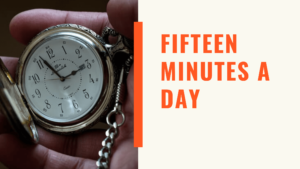 Fifteen minutes a day to a web presence.
Fifteen minutes a day to a web presence.
What if I told you that you could invest fifteen minutes a day in your web presence to see results? In Blogging for a Visual Art Business, I explain that if you get into a consistent habit of writing and working on your blog, you can maintain a system that eventually can take as little as fifteen minutes of your time every day.
This article by Michael Hyatt explains this concept well. Little bits of progress consistently over time will reap the rewards in the long run.
Invest in your art business.
I’m not going to lie, though. You will need to invest some time on the front end. But, after you build your system, you will be able to maintain your online presence in fifteen minutes a day.
Daily is better than monthly.
Working on your system every day keeps you fresh. It helps you to build momentum. It’s easier than sitting down once a month to update things.
Four Necessary Ingredients
If you are serious about starting and maintaining a blog that will drive your art marketing forward, consider the Artist Blogging Toolbox. This program has all four of the necessary ingredients outlined in the article.
1 – Get Clear on Your Goals
The first action in the Toolbox is to outline the goals you want your artist blog to accomplish for your business.
2 – Identify the Right Behavior
After your blog is set up with your first set of posts, you will learn how to set up a system that includes daily behaviors that work to continue to build your presence.
3 – Track Your Progress
The Artist Blogging Toolbox includes tools you can use to plan out your posts and stay on track with your plan.
4 – Accountability Partner
Perhaps the most significant selling point of the Program: You are not alone! This is a self-paced program, but it includes points for checking in and one-on-one meeting time between you and me working specifically on your blog.
Positive Habits Make Progress
Fifteen minutes a day of any proactive activity can help your business. Even if it’s not blogging, try committing fifteen minutes every day to one positive thing you’re already doing to market your work.
If you’d like to set up a fifteen-minute Zoom meeting with me to talk about how the Artist Blogging Toolbox might help you, please drop me a line at becky@artisan-advantage.com.
Would you like weekly updates to help build your art business. I’d love for you to join my email list.
by Becky Sciullo | Feb 26, 2021 | Artist Blogging 101
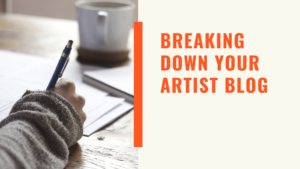 Understand the parts of a blog-based website.
Understand the parts of a blog-based website.
If you’re new to blogging for your art business or just about to build your blog-based website, it’s helpful to have a good knowledge of all of the site’s external components before getting started. Understanding the terms used to describe these parts across most platforms will also make things go smoother when setting up your site.
Here is a quick overview of all of the components you will work with when you set up a blog. Over the next few weeks, I’ll dive into what you should consider for each part when setting up your blog.
Header
The header is the eye-catching section of your site that people notice first. It features the work and sets the tone for your site. If possible, you want to use an image of your work in the header. If your art is two-dimensional, consider work that fits best according to orientation, in most cases a horizontal scene, and then consider the layout. The layout will depend upon the theme or template you are using.
Menu
A website menu is a series of linked items that serve in navigating between the different pages or sections of a website. There are several kinds of menus, depending on the website’s content and design.
The navigation menu is one of the most critical elements of your website. Without it, your visitors will not be able to get to the content they need, won’t understand what content you offer, and will generally exist in a state of confusion regarding your site.
Below is an example of an artist header with the menu at the bottom of the header.
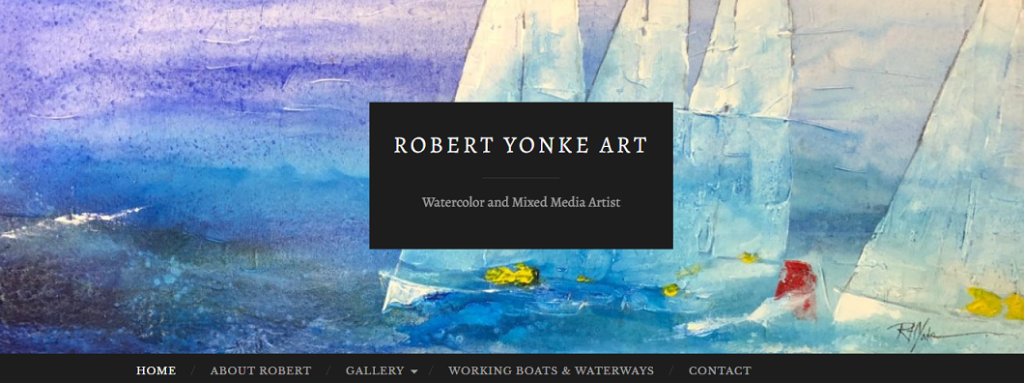
Sidebar
In short, a sidebar is a column placed to the right or left of a webpage’s primary content area.
Commonly used to display different types of information for visitors, it might include the following:
Navigational links to key pages.
Email opt-in forms.
Popular or related posts.
Social media icons or links.
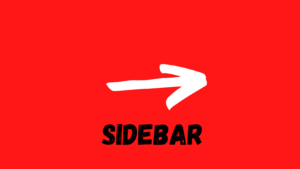
Not all websites need sidebars, and some designs are much better off without one. You can also use them for short bios and other text you might want to share.
While the uses mentioned are some of the most common ways sites put sidebars to work,
The primary advantage of incorporating a sidebar into your website’s design is that it remains visible as users navigate your site. The sidebar allows you to make essential information and features readily available at all times.
Sometimes, sidebars don’t translate well to mobile devices. If you do include a sidebar, consider hiding it for mobile viewers.
Footer
The footer is the area at the bottom of your site that contains information shared across all pages and posts. Footers typically include things like copyrights, addresses, and menus.
Blog posts:
Blog posts are the entries that appear in reverse chronological order. They contain the regular content that you are creating.
You will find posts in Archives, Categories, Recent Posts, and other places on your site.
You can control the number of posts that appear on the blog at one time. As an example, my home page lists my blog posts.
Pages:
Your pages are static. They do not include a date and do not use tags or categories. You can place links to your pages anywhere, but they typically show up in your menu, sidebar, or footer.
You have total control over the arrangement of your pages and can add as many as you like.
More Details to Follow
There may be some nuances across platforms, but for the most part, these are the standard components of a blog-based website. Stay tuned for more detailed posts on each part of the blog in individual posts.
For step-by-step assistance in setting up your artist blog, check out my Artist Blogging Toolbox.
by Becky Sciullo | Feb 5, 2021 | Artist Blogging 101, Learning
*This is an post from April 2020 that has been updated.
How to Choose a Platform For Your Artist Blog
Before you can start blogging, you need to decide which platform you will use. Your platform is the software or system that manages all of the content that you publish. Platforms can also be referred to as content management systems or website builders.
Do you already have a website?
If you have a website for your art business, it may already have a blog function built-in. Many artists build sites on blog platforms but don’t use the blogging feature. If this describes your website, then it isn’t too difficult to start blogging. For artists, some common platforms with blogging features include Squarespace, Wix, Weebly, FASO, WordPress.com, and WordPress.org.
By using the Help or Knowledgebase of your current website platform, you should be able to find detailed instructions on how to use your blog feature.
Do you need a new website?
If you are happy with your current platform, don’t reinvent the wheel. However, you have an outdated website that does not offer a blogging feature, or you are starting from scratch, you need to decide on which platform to build your blog. If you have a site but find the platform difficult to use or not meet your needs, consider a switch.
Recommendations.
My top choice for both artist websites and blogs used to be self-hosted WordPress.org. WordPress.org is the most popular platform in the world. It offers the most flexibility for design, and it is what I use for Artisan Advantage. However, it takes longer to master than some other platforms. And, it is self-hosted, which means you have to find pay for a service to host your site. WordPress.org gets easier to use over time, however, so if you can commit to a longer learning curve, then it might be the choice for you. If you choose to go with WordPress.org, then I recommend checking out Christina Hills and her Website Creation Workshops.
Most of the artists that I help are eager to get started and don’t want to invest a large amount of time learning a system or building a site. Platforms that offer a more straightforward setup and more than adequate features for your blog based website include WordPress.com, FASO, Squarespace, Weebly, and Wix. Of these, WordPress.com and FASO are my favorites for artists.
Confused about WordPress.com vs.Wordpress.org?
You might be confused as to why I’m referring to two different platforms called “WordPress”. Check out this video from Christina Hills at Website Creation Workshop. She does a great job of explaining the differences.
Just Do It!
Your blog will never be perfect. You will always be changing and improving. In my years of blogging, one thing I learned is that sometimes you just have to start.
If starting a blog for your visual art business is something that you’ve wanted to do, I encourage you to get started today using one of the resources above or following allowing with Artist Blogging 101.
Disclosure: Some of the links in the post above are “affiliate links.” This means if you click on the link and purchase the item, I will receive an affiliate commission. Regardless, I only recommend products or services I use personally and believe will add value to my readers.
 Six Art Marketing Ideas
Six Art Marketing Ideas